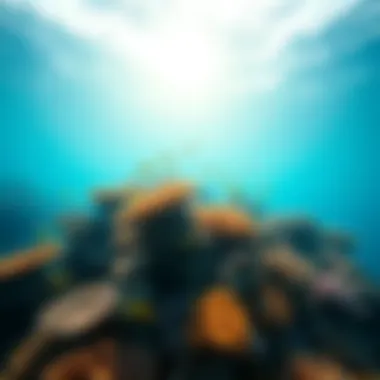Exploring the Oceans: Biodiversity and Culture


Intro
The oceans of our planet are much more than just vast bodies of water; they are intricate ecosystems, rich cultures, and essential resources. Covering over 70% of Earth's surface, they hold a wealth of biodiversity and are intrinsic to regulating climate and weather patterns. From mesmerizing coral reefs to sprawling kelp forests, the sea is brimming with life forms, some of which remain undiscovered.
When exploring the world’s oceans, one cannot overlook the unique bond many cultures share with the surf. Surfing isn't just a sport; it's a community, a lifestyle that intertwines with ecological awareness and appreciation for nature. In this discussion, we'll dive deep into the art of surfing, highlight sustainable practices, and examine the challenges facing our oceans today. For surfers and non-surfers alike, understanding the ocean's voice is vital not just to conservation, but to the human experience itself.
"The ocean stirs the heart, inspires the imagination and brings eternal joy to the soul." - Wyland
As we venture further into this exploration, we will touch on key aspects including surfing techniques, lifestyle choices, and the pressing issues our oceans are grappling with. Let's ride the wave of knowledge together and foster a deeper connection with our seas.
Preamble to the Oceans
The ocean, often perceived merely as a vast blue expanse, is actually a treasure trove of complexity and significance. This section sets the stage for understanding the multifaceted nature of the world's oceans. It's not just about water; it's about life, culture, and the very health of our planet. The oceans cover more than 70% of the Earth's surface and are riddled with mysteries that continue to baffle scientists and researchers. From the breathtaking biodiversity nestled within coral reefs to the intricate networks of ocean currents that influence global weather patterns, understanding oceans is essential to grasp the broader environmental narrative.
Recognizing the depth of what governs marine ecosystems allows us to appreciate both the beauty and the fragility of these environments. The oceans aren’t simply off the coastlines; they entwine with our lives in ways we often overlook. Their survival depends on our awareness and actions.
Historical Perspective
The journey of humanity and the ocean goes way back. Ancient civilizations, such as the Phoenicians and the Polynesians, were adept sailors who harnessed the whims of the sea for trade and exploration. Their prowess not only shaped commerce but also contributed to cultural exchanges that enriched societies far and wide. As societies evolved, so did our understanding of the oceans. In the 15th century, the Age of Exploration unfolded, leading to discoveries that redefined maps and opened new frontiers.
However, this exploration did not come without cost. The ensuing centuries often saw the oceans treated as a boundless resource, exploited without consideration for long-term consequences. Today, we look back at this history, reminding ourselves that our relationship with the oceans is not new, but the urgency with which we must protect them is indeed pressing.
Geographical Overview
Wandering through a map of the world, oceans appear as vast, interconnected bodies of water. Major divisions include the Pacific, Atlantic, Indian, Southern, and Arctic Oceans, each unique in terms of landscape, biodiversity, and human connection. The Pacific, for instance, is the largest and deepest, housing island nations rich in culture and marine life.
- The Atlantic Ocean serves as a crucial channel for trade and has historical significance connecting continents.
- The Indian Ocean, rich in marine resources, is becoming increasingly vital as trade routes shift to accommodate growing economies.
The touchpoints of geography include coastal ecosystems, which are not only beautiful but also critical for sustaining diverse marine species and protecting shorelines from erosion. The geography of the oceans is as diverse as the cultures that surround them. From the thriving coral reefs of Australia’s Great Barrier Reef to the icy waters of the Arctic, the oceans are a testament to the earth’s ecological tapestry.
Oceans not only serve as a natural resource but also play an integral role in the cultural identity of coastal communities. The connection between humans and oceans is intricate—marked by centuries of stories, traditions, and lessons learned. Understanding this interplay is essential as we delve deeper into the importance of preserving the rich heritage and health of our oceans.
The Significance of Oceans
The oceans are more than just vast bodies of water; they are crucial to the well-being of our planet and its inhabitants. Covering over 70% of the Earth's surface, these saline expanses serve numerous functions that are pivotal for life as we know it. This section delves into the significance of oceans, focusing on their role in climate regulation and the critical biodiversity they support, particularly as it relates to the surfing community and coastal cultures.
Oceans and Climate Regulation
Oceans play an essential role in climate regulation through a complex interplay of physical and biological processes. They absorb about 30% of the carbon dioxide produced by human activities, acting as a buffer against climate change. This natural carbon sink helps mitigate the effects of greenhouse gas emissions, stabilizing global temperatures. The influence of oceans extends beyond carbon absorption; they also regulate heat distribution on Earth.
- Ocean currents, like the Gulf Stream, circulate warm and cold water around the globe, affecting weather patterns and temperatures in coastal regions. This circulation creates a moderating effect on climates, making areas like Europe milder than they would otherwise be.
- Furthermore, the oceans produce over half of the world's oxygen through the photosynthetic processes of phytoplankton, which are microscopic plant-like organisms that drift in sea currents. By maintaining atmospheric balance, these organisms are indispensable in sustaining life on land.
However, the delicate equilibrium of the oceanic systems is under threat due to rising temperatures and acidification. Increasing CO2 levels lead to warmer waters, which can affect marine species' habitats and breeding patterns. Surfers and coastal communities must understand that a healthy ocean means preserving the conditions necessary for the waves they cherish.
Role in Biodiversity
The oceans are a cornucopia of biodiversity, housing millions of species ranging from the smallest phytoplankton to the gigantic blue whale. This diversity is not merely a matter of aesthetic appeal; it has significant implications for ecological stability and human survival.


- Coral reefs, often referred to as the "rainforests of the sea," demonstrate high levels of biodiversity. They provide habitat for roughly 25% of all marine species, despite covering only 1% of the ocean floor. These ecosystems offer benefits beyond wildlife; they protect coastlines from erosion and are vital for fishing industries that support local economies.
- Additionally, oceanic biodiversity contributes to genetic variety vital for disease resistance and health of marine organisms, which in turn supports global food systems and economies.
It’s crucial to recognize that the degradation of ocean habitats can lead to the loss of species, which affects fishermen, surfers, and anyone who enjoys ocean recreation. As we navigate the complexities of ocean conservation, acknowledging the interdependence of species and their environments becomes essential.
"Each drop in the ocean counts; every wave tells a story. Our actions today will echo in the tides of tomorrow."
In summary, understanding the significance of oceans involves appreciating their role in climate balance and their rich biodiversity. For surfers, the health of ocean ecosystems directly correlates to wave conditions and surf experiences, reinforcing the idea that protecting our oceans is not just an environmental issue but a cultural one as well.
Surfing and Ocean Culture
Surfing is not just a sport; it embodies a lifestyle deeply intertwined with ocean culture. For those who paddle out, the surf is a calling, an escape, and often a sanctuary. The relationship between surfers and the ocean is as profound as the waves that draw them in. It’s vital to understand how oceanic habitats nourish this culture, while also shaping attitudes towards preservation and responsible use. As surfers engage with the vibrant rhythms of the sea, they contribute to a broader narrative about environmental awareness and stewardship.
The Evolution of Surf Culture
Surf culture traces its roots back to ancient Polynesian societies, where riding waves was more than just a recreational activity; it was a form of spiritual expression. In those days, the craft of making surfboards was a sacred art, passed down through generations. As the years rolled on, surfing found its way to the mainland United States in the early 20th century. It began evolving under the influence of various social movements, particularly during the 1960s counterculture explosion. The surf music scene, bolstered by bands like The Beach Boys, romanticized the lifestyle, putting it in the spotlight. This period showed surfing as an emblem of freedom, youth and rebellion.
As surfing grew, so did its subcultures. From the mellow vibes of longboard riders to the adrenaline-fueled shortboarders, each group adopted distinct styles, music, and even fashion. These diversifications helped expand surfing’s appeal, allowing it to resonate across different demographics and regions—notably in places such as California, Hawaii, and Australia. In more recent years, surfing's adaptation into competitive formats and its inclusion in the Olympics have further transformed its cultural significance. Now, it melds tradition with modernity, fueling ongoing discussions about environmental preservation and eco-consciousness in the surfing community.
Iconic Surfing Destinations
Certain locations have become synonymous with the surfing culture, etched into the memory of enthusiasts worldwide. Here are a few iconic surfing destinations that not only offer stunning waves but also rich histories and vibrant local cultures:
- Pipeline, Hawaii: Known for its legendary waves that break over a shallow reef, Pipeline is a rite of passage for many surfers. The location is as perilous as it is beautiful, attracting top-tier competitions each year.
- Banzai Pipeline, North Shore: The pinnacle of surfing culture where professional surfers flaunt their skills. The intensity of the waves provides a canvas for mastering surfing techniques.
- Jeffreys Bay, South Africa: Famous for its long, fast right-hand point break, Jeffreys Bay is renowned worldwide and regularly hosts the World Surfing League competitions.
- Gold Coast, Australia: This destination promises consistency and vibrant city life. Surfers flock here to ride a variety of waves from beginner-friendly breaks to challenging swells.
"Each wave is unique, like a fingerprint of the ocean, creating a connection between the surfer and the sea."
Unique characteristics of these destinations not only promote surfing as a sport but also foster tourism and local economies. They remind us that while riding the waves is exhilarating, it’s crucial to maintain respect for the marine ecosystems that support this culture.
Leaning into the lifestyle associated with surfing opens pathways to understanding how human interactions with these vast oceans can nurture both community spirit and environmental responsibility. As surfers advocate for the preservation of these storied locales, they inherently weave their culture with the health of the ocean, driving a compelling narrative that transcends mere recreation.
Oceanic Ecosystems
Oceanic ecosystems are not just random bunches of water and life; they are intricate webs of interactions that support a remarkable array of organisms, each playing a unique role in the health of our planet. These ecosystems provide essential services, like regulating climate, supporting food webs, and sustaining human livelihoods. Understanding the depths of these ecosystem is crucial, especially as we dive into topics such as coral reefs and marine life biodiversity.
Coral Reefs and Their Importance
Coral reefs, often dubbed the rainforests of the sea, are vital not only for their breathtaking beauty but also for the wealth of biodiversity they support. These underwater gardens are home to a stunning variety of marine life, from colorful fish to mysterious mollusks. Coral reefs cover less than 1% of the ocean floor, yet they provide habitat for approximately 25% of all marine species. Without these ecosystems, many species would face extinction, leading to significant disruptions in the marine food chain.
Key Benefits of Coral Reefs:
- Biodiversity Hotspots: Coral reefs act as nurseries for many fish species, providing a safe environment for young fish to grow and thrive.
- Coastal Protection: They serve as barriers against storm surges and erosion, shielding coastal communities from the brunt of waves and preventing habitat loss.
- Economic Value: For many coastal communities, coral reefs contribute to tourism and fishing, essential components of local economies.
However, the health of coral reefs is under siege due to a myriad of threats, including climate change, which leads to coral bleaching, and ocean acidification, which weakens the coral structure. This is a call to arms for surfers, environmentalists, and anyone who cares about the health of our oceans. Through collective efforts and awareness, we can protect these endangered ecosystems.
Marine Life Biodiversity
Diving into marine life biodiversity reveals a vibrant tapestry of species, each with a role in maintaining the ecological balance of the oceans. From the majestic blue whale, the largest animal on Earth, to the tiniest plankton, marine organisms interconnect in ways that are both fascinating and complex. The diversity found in oceans underpins global ecosystems, impacts human factors such as food security, and influences climatic conditions.


Aspects of Marine Biodiversity:
- Species Interdependence: Every species plays a role, whether they are producers, consumers, or decomposers. The loss of even one species can have ripple effects throughout the entire ecosystem.
- Unique Adaptations: Marine species have evolved fascinating adaptations to survive in their specific environments, showcasing the wonders of evolution and resilience. For instance, the ability of certain deep-sea creatures to bioluminesce enhances their survival amid darkness.
- Future Potential: Many marine organisms hold the key to advancements in medicine and biotechnology, with numerous pharmaceutical compounds being derived from marine life.
Embracing the importance of biodiversity encourages a rethink of how humans interact with oceans. If we do not advocate for and protect marine biodiversity, we risk irreversible damage, jeopardizing both our wellbeing and that of future generations.
"The preservation of marine ecosystems is not an option; it is a necessity for sustainable living on Earth."
In summary, oceanic ecosystems, especially coral reefs and the marine life they sustain, are cornerstone elements that warrant our utmost attention and protection. As pressures mount from human activities, understanding and appreciating these ecosystems becomes essential for their survival and the wellbeing of our planet.
Threats to Ocean Health
The oceans of our planet, while rich in beauty and diversity, face multitude threats that jeopardize their health and sustainability. Protecting these vast bodies of water is not just an environmental concern but a necessity for humanity's survival. As we delve into the pressing issues affecting ocean health, it is vital to understand how pollution, climate change, and overfishing play critical roles in the degradation of these ecosystems. Each of these elements not only impacts marine life but also holds dramatic consequences for human populations reliant on oceans for food, recreation, and even livelihood.
Pollution and Its Impact
Pollution in our oceans presents itself in diverse forms, ranging from plastic waste to chemical runoff. Every year, an estimated 8 million tons of plastic find their way into ocean waters. This plastic not only harms marine life, as creatures ingest it or become entangled, but it also disrupts entire ecosystems. For instance, when small fish consume microplastics, the chemical toxins can ascend the food chain, ultimately reaching humans. It’s a classic case of poisoning the well.
On another front, agricultural runoff, laden with fertilizers and pesticides, finds its way into rivers and eventually into the ocean. This concoction causes eutrophication, leading to dead zones where oxygen levels plummet, suffocating marine species. In essence, pollution alters the complex balance of life in oceans, making recovery a daunting battle.
"The ocean is the beating heart of our planet. Polluting it is akin to poisoning ourselves."
Climate Change Consequences
The ramifications of climate change ripple across all realms of oceanic health. Rising temperatures are not only warming ocean waters, but they are also causing ocean acidification. This process threatens shellfish and coral reefs, which are vital habitats for countless marine organisms. Coral reefs, often termed the rainforests of the sea, are under siege from bleaching events exacerbated by warmer waters. When stressed, corals expel the vibrant algae living symbiotically within them, leading to their whitish appearance and eventual death.
Moreover, altered sea temperatures and patterns disrupt migratory pathways for fish as well, impacting fishing industries and communities worldwide. Nations relying on fish as their primary protein source find themselves in precarious positions when fish populations dwindle due to climate-related changes. It’s a cycle of consequences that not only damages marine ecosystems but, in turn, threatens the very fabric of coastal communities.
Overfishing and Resource Depletion
Overfishing poses one of the gravest threats to ocean health. When fish are taken at a faster rate than they can reproduce, populations diminish to levels that can lead to extinction. Species such as the Atlantic cod have become iconic cases of overfishing’s disastrous effects, showcasing how imbalances can take years, if not decades, to remedy. One might say, indulging in the short-term gain of abundant fish stocks can lead to a long-term tragedy of the commons.
The ramifications extend far beyond just the species removed from the oceans. As specific fish populations decline, ecosystems face significant shifts. Apex predators, for instance, rely on a balanced population of prey fish to thrive. The lack of these essential species can result in food webs collapsing, creating further instability in ocean ecosystems.
Efforts are being made to combat overfishing through sustainable practices and regulations, yet significant change remains necessary. It is crucial for both policymakers and communities to embrace a mindset of sustainability, considering not only the immediate benefits but the long-term implications of their actions.
Ocean Conservation Efforts
The oceans, despite their vastness and depth, are under constant strain from human activities and natural phenomena. Conservation is not merely an option; it’s a necessity. Protecting these blue wonderlands enhances ecological health, preserves biodiversity, and maintains the balance of our climate systems. It’s crucial to remember that every ripple in the ocean affects us all, poetically uniting humanity in this shared responsibility.
Global Initiatives
Worldwide efforts to conserve oceans are often spearheaded by organizations that understand their significance. Programs such as the United Nations’ Sustainable Development Goal 14 advocate for the conservation and sustainable use of oceans, seas, and marine resources. This goal aims to take action to prevent pollution and overfishing, bolster marine biodiversity, and combat climate change.
Some notable global initiatives include:
- Marine Protected Areas (MPAs): These are special regions where human activity is restricted to preserve marine biodiversity. Regions like the Great Barrier Reef in Australia serve as a prime example of MPA implementation, helping to protect delicate coral ecosystems.
- Global Fishing Watch: This initiative utilizes satellite technology to monitor fishing activity globally and ensure sustainable practices, significantly reducing illegal fishing.
- Ocean Cleanup Project: Targeting plastic waste, this project employs innovative designs and technologies to collect debris floating in the ocean.


These initiatives embody a collective spirit to tackle ocean-related issues on a grand scale, presenting opportunities to encourage individual contributions. Global actions can lead to positive local outcomes, showcasing how collaboration can yield fruitful results.
Community-Led Efforts
While global initiatives play a significant role, local communities are also at the heart of effective ocean conservation. Grassroots movements often bring change where top-down approaches may falter. Individuals living in coastal areas know their environment intimately and can advocate for its health in ways that resonate with their lives and culture.
Some impactful community-led efforts include:
- Beach Cleanups: Local organizations often arrange events that gather community members to clean up beaches, raising awareness about waste management and its impact on marine life.
- Citizen Science Projects: Initiatives like Surfrider Foundation’s “Blue Water Task Force” allow surfers and beachgoers to collect water quality data, directly contributing to local policy changes that protect marine environments.
- Educational Workshops: Local NGOs often run workshops to educate residents about sustainable practices, mangrove restoration, and coral reef conservation, fostering a culture of respect for marine ecosystems.
“We do not inherit the Earth from our ancestors; we borrow it from our children.”- Native American Proverb
By engaging local residents, these efforts create a profound sense of ownership and responsibility. The interconnectedness between humans and the ocean becomes apparent as community members actively contribute to the health of the waters that sustain them, proving that waves of change often begin at the shore.
These conservation efforts, comprising both global and community initiatives, paint a hopeful picture for the oceans. As we delve deeper into understanding their importance, it’s imperative to align our actions with the ocean’s needs and advocate for a sustainable future.
For more details on ocean conservation, resources such as National Oceanic and Atmospheric Administration and Marine Conservation Society provide inn-depth insights and opportunities for engagement.
Understanding these nuances of ocean conservation not only raises awareness but also ignites a passion within us, the surf community, to protect that which we love.
Future Prospects for the Oceans
The future of the oceans is an essential topic, primarily because it mirrors our global challenges and aspirations. As we forge ahead, understanding how technology and governance will shape marine environments is crucial. The oceans serve as more than just a backdrop for our existence; they are pivotal in regulating climate, providing sustenance, and nurturing biodiversity. Addressing the health of our seas is intertwined with our fates, and that's why contemplating their future prospects matters tremendously.
Innovations in Marine Technology
As we look towards the horizon, groundbreaking advances in marine technology are reshaping how we interact with oceanic environments. Notably, innovations such as autonomous underwater vehicles (AUVs) are revolutionizing our capacity to explore and monitor these vast waters. These high-tech marvels can gather data on temperature, salinity, and marine life without the limitations of manned expeditions. Imagine deploying fleets of these underwater drones to chart parts of the ocean never seen before.
Furthermore, satellite imagery has come a long way. It allows scientists to observe coral reefs, monitor fishing activity, and track oil spills in real-time. For surfers, improved wave prediction technologies mean better understanding of surf conditions, leading to an enhanced experience on the water. Given the immense swathes of uncharted territories in our oceans, these technologic advancements bring optimism about sustainable practices and conservation efforts.
- Benefits of Marine Technology Innovations:
- Enhanced data collection from remote regions
- Improved fishery management tools
- Greater insight into climate change effects
Technologies to grow coral reefs in controlled environments are also being tested. These lab-grown corals are then transplanted back into the oceans, helping to counteract the damage done by bleaching and habitat loss. Continued investment in research and educational programs will establish a strong foundation for future ocean conservation efforts.
The Role of Policy in Ocean Management
As we dive deeper into the ocean's future, policy plays a paramount role in the sustainable management of these critical resources. National and international agreements are necessary to unify efforts in protecting marine environments. As the saying goes, **
Culmination
In closing this journey through the vast and intricate world of oceans, it's vital to underscore the multilayered significance they hold not only for marine ecosystems but also for our societal fabric. Our oceans, stretching far and wide, are not merely giant bodies of water; they are dynamic entities that regulate climates, support countless species, and offer avenues for human recreation and inspiration.
Reflecting on Ocean Interconnectedness
Every ripple and wave tells a story of interconnectedness. The oceans act as vital arteries, transporting nutrients and maintaining the delicate balance necessary for life on Earth. The health of our oceans is closely tied to human actions—pollution, overfishing, and climate change create a feedback loop that threatens marine habitats.
- The phenomenon of ocean currents is a perfect example. These currents not just influence weather patterns but carry with them the very essence of biodiversity. Migratory patterns of marine species are influenced by these currents, linking distant geographical regions and species.
- Furthermore, the coastal waters that surfers cherish are deeply impacted by this interconnectedness. Pollution and temperature changes can alter wave patterns, impacting surf quality and safety.
"Our every action has a ripple effect, one that transcends geographical boundaries, reminding us of our shared responsibility."
As surfing enthusiasts, athletes, lifestyle bloggers, and environmental advocates gather under the umbrella of ocean culture, it’s essential for us to recognize the reciprocal relationship we share with these waters. It’s not simply about riding waves but also about safeguarding the environment that creates them. Integrating sustainable practices into our beach habits can help ensure that future generations can experience the ocean as we do today.















